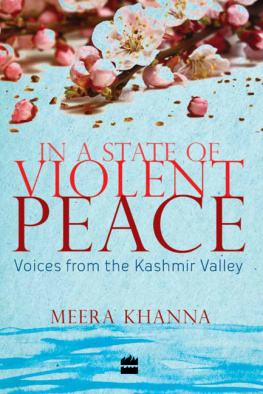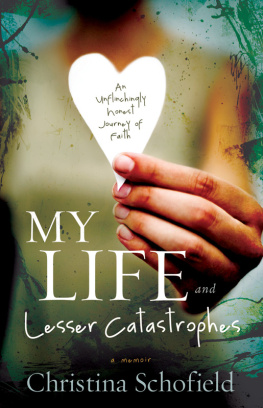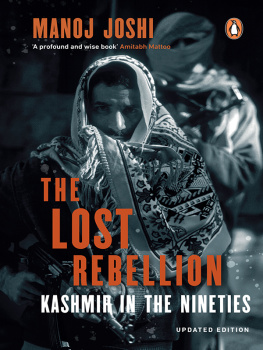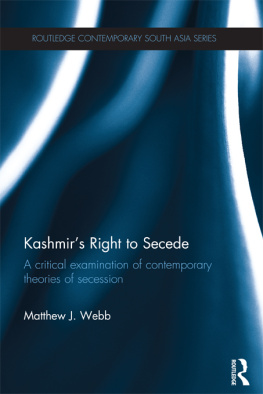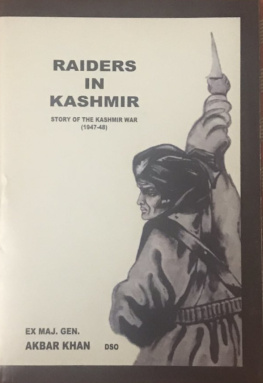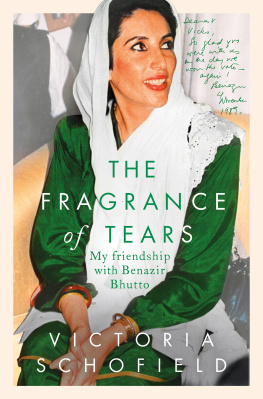Schofield Victoria - Kashmir in Conflict
Here you can read online Schofield Victoria - Kashmir in Conflict full text of the book (entire story) in english for free. Download pdf and epub, get meaning, cover and reviews about this ebook. year: 2020, publisher: I. B. Tauris & Company, Limited, genre: Politics. Description of the work, (preface) as well as reviews are available. Best literature library LitArk.com created for fans of good reading and offers a wide selection of genres:
Romance novel
Science fiction
Adventure
Detective
Science
History
Home and family
Prose
Art
Politics
Computer
Non-fiction
Religion
Business
Children
Humor
Choose a favorite category and find really read worthwhile books. Enjoy immersion in the world of imagination, feel the emotions of the characters or learn something new for yourself, make an fascinating discovery.
- Book:Kashmir in Conflict
- Author:
- Publisher:I. B. Tauris & Company, Limited
- Genre:
- Year:2020
- Rating:3 / 5
- Favourites:Add to favourites
- Your mark:
- 60
- 1
- 2
- 3
- 4
- 5
Kashmir in Conflict: summary, description and annotation
We offer to read an annotation, description, summary or preface (depends on what the author of the book "Kashmir in Conflict" wrote himself). If you haven't found the necessary information about the book — write in the comments, we will try to find it.
Kashmir in Conflict — read online for free the complete book (whole text) full work
Below is the text of the book, divided by pages. System saving the place of the last page read, allows you to conveniently read the book "Kashmir in Conflict" online for free, without having to search again every time where you left off. Put a bookmark, and you can go to the page where you finished reading at any time.
Font size:
Interval:
Bookmark:

KASHMIR IN CONFLICT

I.B. TAURIS
Bloomsbury Publishing Plc
50 Bedford Square, London, WC1B 3DP, UK
1385 Broadway, New York, NY 10018, USA
29 Earlsfort Terrace, Dublin 2, Ireland
BLOOMSBURY, I.B. TAURIS and the I.B. Tauris logo are trademarks of Bloomsbury Publishing Plc
First published in Great Britain 1996
This edition published in 2021
Copyright Victoria Schofield, 1996, 2021
Victoria Schofield has asserted her right under the Copyright,
Designs and Patents Act, 1988, to be identified as Author of this work.
For legal purposes the Acknowledgements on p. ix constitute an extension of this copyright page.
Cover image Elite Indian soldiers of the Rashtriya Rifles, Kashmir, India. ( Martin Adler/ Pansons Pictures)
All rights reserved. No part of this publication may be reproduced or transmitted in any form or by any means, electronic or mechanical, including photocopying, recording, or any information storage or retrieval system, without prior permission in writing from the publishers.
Bloomsbury Publishing Plc does not have any control over, or responsibility for, any third-party websites referred to or in this book. All internet addresses given in this book were correct at the time of going to press. The author and publisher regret any inconvenience caused if addresses have changed or sites have ceased to exist, but can accept no responsibility for any such changes.
A catalogue record for this book is available from the British Library.
A catalog record for this book is available from the Library of Congress.
ISBN: PB: 978-0-7556-0718-1
ePDF: 978-0-7556-0719-8
eBook: 978-0-7556-0720-4
To find out more about our authors and books visit
www.bloomsbury.com and sign up for our newsletters.
Contents
Map credits: 1, Russell Townsend; 2, 3, 4, 5, 6, 7 Phil Armstrong 10 Jamie Whyte.
'A country of such striking natural beauty must, surely, at some period of its history have produced refined and noble people, writes Sir Francis Young-husband in his History of Kashmir. So indeed, and during my own journey through Kashmirs contemporary history, I have been privileged to make contact with some of them. In the present day, I am grateful to the three main protagonists in the current struggle: the Indians, Pakistanis and the Kashmiris and, by this, I include all the inhabitants of the once princely state. My thanks also go to the governments of India and Pakistan, whose representatives have always received me openly, as well as their respective High Commissions in London; in addition, I should like to thank the members of the government of the state of Jammu and Kashmir, the members of the All Parties Hurriyat Conference, the Azad government of Jammu and Kashmir and numerous officials and private individuals.
No book is written single-handedly. All those I interviewed, often at short notice, could not have been more willing to open their hearts and homes to me in order for me to understand their story. Where they have not been able to resolve their differences at the negotiating table, I have attempted to sit with them independently, listen to their grievances and share their dreams. They, too, are contributors to this book. I am also grateful for permission to quote from numerous works listed in the bibliography; I have done so with special attention to those first-hand accounts which capture an event far better than it is sometimes possible to do with the wisdom of hindsight. In quoting the views and opinions of others, I have also wanted to give the reader the benefit of their analyses as well as my own.
I am grateful to all those who assisted me during my long years of research on Kashmir, especially David Page, whose advice has always been invaluable. I should also like to record my thanks to all those who have contributed to my understanding of Jammu and Kashmir, in particular the family of Gulam and Bashir Butt and Dr Rashmi Shankar, who, since 1981, have given me homes in Delhi and Srinagar. At an early stage in my research Professor Alastair Lamb also shared valuable insights. Finally, I should like to pay may respects to Benazir Bhutto, former Prime Minster of Pakistan, whose personal encouragement of my understanding of the Kashmir issue was part of her own desire to see peace in South Asia, before her assassination in December 2007.
My thanks go to the staff of the British Library for the many hours I have spent researching in the library. I am grateful for permission to quote from the books and manuscripts I have used from the collections. I am also grateful to the London Library for its liberal lending policy, and for Carlyle membership, the United Nations Library and the Royal Geographical Society, whose collection of maps I have consulted. Finally, I should like to thank my agent, Sara Menguc, my publisher, Iradj Bagherzade, and his colleagues at I.B.Tauris, for publishing my first book, Kashmir in the Crossfire, in 1996, and updated editions, Kashmir in Conflict, in 2000, 2003 and 2010 and to I.B.Tauris, Bloomsbury for another updated edition in 2021; my husband, Stephen Willis, my children, Alexandra, Anthony and Olivia and my friends, all of whom have supported me emotionally and practically while I have been trying to understand the complexities of Kashmir. Unless otherwise stated, all views and conclusions expressed in this book are my own.
Who has not heard of the Vale of Cashmere,
With its roses the brightest that earth ever gave,
Its temples and grottos, and fountains as clear
As the love-lightened eyes that hang over the wave?
In 1846, under the terms of the Treaty of Amritsar, the British sold the beautiful valley of Kashmir to the Hindu Dogra ruler, Gulab Singh. It was not a sale in the traditional sense of the word since Britain was not physically occupying the land it sold, but rather a confirmation of an existing state of affairs where by Gulab Singh had been administering the valley on behalf of the Sikhs. Now, as Maharajah of Jammu and Kashmir in his own right, he could include Kashmir as the 'Jewel among his other territorial possessions, which included Jammu, Ladakh, Baltistan and numerous hill states, through which flowed the river Indus and its tributaries to the east. Thus, people of different linguistic, religious and cultural traditions were all brought under the jurisdiction of one ruler. The inclusion of the predominantly Muslim, and more densely populated, valley meant that Hindus, Sikhs and Buddhists were in the minority. When, a century later, the sub-continent was partitioned at independence in 1947, Maharaja Hari Singh, Gulab Singhs great-grandson, could not decide whether to join the new dominion of Pakistan or India. For over two months, his state remained independent. In October, after large numbers of tribesmen from Pakistans North-West Frontier invaded the state, he agreed to join India. His decision was immediately contested by Pakistan on the basis of the states majority Muslim population. War between India and Pakistan was halted in 1949 by a ceasefire supervised by the recently founded United Nations.
For over seventy years, India and Pakistan have fought over Jammu and Kashmir both on the battlefield and at the negotiating table; both countries wanted to absorb it within their borders, neither of them has succeeded in doing so entirely. One-third of the former princely state is administered by Pakistan, known as Azad (Free) Jammu and Kashmir (AJK) and Gilgit-Baltistan (formerly the Northern Areas) two-thirds, formerly known as the state of Jammu and Kashmir, are controlled by India; this area includes the regions of Ladakh, Jammu and the prized valley of Kashmir. On 5 August 2,019 the Indian government altered the status and the name, creating two Union Territories. One is called Jammu and Kashmir and, on the map, includes AJK; the other Union Territory is called Ladakh and includes Gilgit-Baltistan, reflecting Indias position that, due to the Maharajahs accession, the whole region is still legally part of India.
Font size:
Interval:
Bookmark:
Similar books «Kashmir in Conflict»
Look at similar books to Kashmir in Conflict. We have selected literature similar in name and meaning in the hope of providing readers with more options to find new, interesting, not yet read works.
Discussion, reviews of the book Kashmir in Conflict and just readers' own opinions. Leave your comments, write what you think about the work, its meaning or the main characters. Specify what exactly you liked and what you didn't like, and why you think so.




